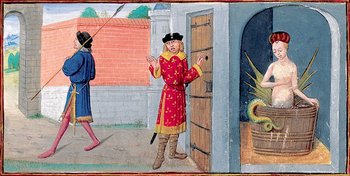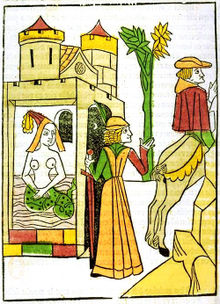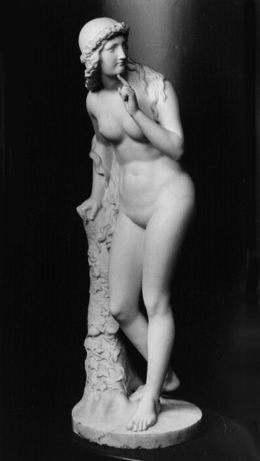Traveling within the World
Linking your favorite traveling artists across the globe
Melusine (or Melusina) is a figure of European legends and folklore, a feminine spirit of fresh waters in sacred springs and rivers. AppearanceShe is usually depicted as a woman who is a serpent or fish (much like a mermaid) from the waist down. She is also sometimes illustrated with wings, two tails or both, and sometimes referred to as a nixie.
Literary versionsThe most famous literary version of Melusine tales, that of Jean d'Arras, compiled about 1382 - 1394 was worked into a collection of "spinning yarns" as told by ladies at their spinning. The tale was translated into the English language c. 1500, and often printed in both the 15th century and the 16th century. (There is also a prose version called the Chronique de la princesse.) It tells how Elynas, the King of Albany (a poetical euphemism for Scotland) went hunting one day and came across a beautiful lady in the forest. She was Pressyne, mother of Melusine. He persuaded her to marry him but she agreed, only on the promise — for there is often a hard and fatal condition attached to any pairing of fay and mortal — that he must not enter her chamber when she birthed or bathed her children. She gave birth to triplets. When he violated this taboo, Pressyne left the kingdom, together with her three daughters, and traveled to the lost Isle of Avalon. The three girls — Melusine, Melior, and Palatyne — grew up in Avalon. On their fifteenth birthday, Melusine, the eldest, asked why they had been taken to Avalon. Upon hearing of their father's broken promise, Melusine sought revenge. She and her sisters captured Elynas and locked him, with his riches, in a mountain. Pressyne became enraged when she learned what the girls had done, and punished them for their disrespect to their father. Melusine was condemned to take the form of a serpent from the waist down every Saturday. Raymond of Poitou came across Melusine in a forest in France, and proposed marriage. Just as her mother had done, she laid a condition, that he must never enter her chamber on a Saturday. He broke the promise and saw her in the form of a part-woman part-serpent. She forgave him. Only when, during a disagreement with her, he called her a "serpent" in front of his court, did she assume the form of a dragon, provide him with two magic rings and fly off, never to return. LegendsMelusine legends are especially connected with the northern, most Celtic areas of Gaul and the Low Countries. Sir Walter Scott told a Melusine tale in Minstrelsy of the Scottish Border (1802 -1803) confident that
When Count Siegfried of the Ardennes bought the feudal rights to Luxembourg in 963, his name became connected with the local version of Melusine. In 1997 Luxembourg issued a postage stamp commemorating this Melusina, with essentially the same magic gifts as the ancestress of the Lusignans. This Melusina magically made the castle of Bock appear the morning after their wedding. On her terms of marriage, she too required one day of absolute privacy each week. Alas, Sigefroid, as the Luxembourgeois call him, "could not resist temptation, and on one of the forbidden days he spied on her in her bath and discovered her to be a mermaid. When he let out a surprised cry, Melusina caught sight of him, and her bath immediately sank into the solid rock, carrying her with it. Melusina surfaces briefly every seven years as a beautiful woman or as a serpent, holding a small golden key in her mouth. Whoever takes the key from her will set her free and may claim her as his bride." [1] Martin Luther knew and believed in the story of another version of Melusine, die Melusina zu Lucelberg (Lucelberg in Silesia), whom he referred to several times as a succubus (Works, Erlangen edition, volume 60, pp 37–42). Johann Wolfgang von Goethe wrote the tale of Die Neue Melusine in 1807 and published it as part of Wilhelm Meisters Wanderjahre. The playwright Franz Grillparzer brought Goethe's tale to the stage and Felix Mendelssohn provided a concert overture "The Fair Melusina," his Opus 32. Melusine is one of the pre-Christian water-faeries who were sometimes responsible for changelings. The "Lady of the Lake", who spirited away the infant Lancelot and raised the child, was such a water nymph. For other European water sprites dangerous to humans, especially men, see Lorelei, Nixie. "Melusina" would seem to be an uneasy name for a girl-child in these areas of Europe, but Ehrengard Melusine von der Schulenburg, Duchess of Kendal and Munster, mistress of George I of Great Britain, was christened Melusine in 1667. ArtHeraldryMelusine is sometimes used as a heraldic figure, typically in German and Scandinavian Coats of arms, where she supports one scaly tail in each arm. She may appear crowned. The Coat of Arms of Warsaw features a siren (identified in Polish as a syrenka) very much like a depiction of Melusine, brandishing a sword and shield. She is the water-spirit from the Vistula who identified the proper site for the city to Boreslaus of Masovia in the late 13th century. Other usagesA stylized cartoon version of a siren, which is similar to some of the Melusine legends, serves as the mascot that appears in the Starbucks logo to advertise the coffee chain. In fiction, the Melusine legend is part of A.S. Byatt's Possession. One of the main characters, Christabel LaMotte, writes an epic poem about Melusina.
References
|
Tags:
Replies to This Discussion
Events
-
2014 is the Chinese Year of the Horse
February 17, 2026 at 12am to February 5, 2027 at 12am – where & how you choose
Birthdays
Birthdays Today
Important (read & understand)
Skype: Travelingraggyman
Email and Instant Messenger:
TravelerinBDFSM @ aol/aim; hotmail; identi.ca; live & yahoo
OR
Travelingraggyman @ gmail and icq ***

1AWARD UPDATES & INFORMATION
10,000 votes - Platinum Award
5,000 votes - Gold Award
2,500 votes - Silver Award
1,000 votes - Bronze Award
300 votes - Pewter Award
100 votes - Copper Award
Member of the Associated Posting System {APS}
This allows members on various sites to share information between sites and by providing a by line with the original source it credits the author with the creation.
Legal Disclaimer
***************We here at Traveling within the World are not responsible for anything posted by individual members. While the actions of one member do not reflect the intentions of the entire social network or the Network Creator, we do ask that you use good judgment when posting. If something is considered to be inappropriate it will be removed
Site Meter
This site is strictly an artist operational fan publication, no copyright infringement intended
Patchwork Merchant Mercenaries had its humble beginnings as an idea of a few artisans and craftsmen who enjoy performing with live steel fighting. As well as a patchwork quilt tent canvas. Most had prior military experience hence the name.
Patchwork Merchant Mercenaries.
Vendertainers that brought many things to a show and are know for helping out where ever they can.
As well as being a place where the older hand made items could be found made by them and enjoyed by all.
We expanded over the years to become well known at what we do. Now we represent over 100 artisans and craftsman that are well known in their venues and some just starting out. Some of their works have been premiered in TV, stage and movies on a regular basis.
Specializing in Medieval, Goth , Stage Film, BDFSM and Practitioner.
Patchwork Merchant Mercenaries a Dept of, Ask For IT was started by artists and former military veterans, and sword fighters, representing over 100 artisans, one who made his living traveling from fair to festival vending medieval wares. The majority of his customers are re-enactors, SCAdians and the like, looking to build their kit with period clothing, feast gear, adornments, etc.
Likewise, it is typical for these history-lovers to peruse the tent (aka mobile store front) and, upon finding something that pleases the eye, ask "Is this period?"
A deceitful query!! This is not a yes or no question. One must have a damn good understanding of European history (at least) from the fall of Rome to the mid-1600's to properly answer. Taking into account, also, the culture in which the querent is dressed is vitally important. You see, though it may be well within medieval period, it would be strange to see a Viking wearing a Caftan...or is it?
After a festival's time of answering weighty questions such as these, I'd sleep like a log! Only a mad man could possibly remember the place and time for each piece of kitchen ware, weaponry, cloth, and chain within a span of 1,000 years!! Surely there must be an easier way, a place where he could post all this knowledge...
Traveling Within The World is meant to be such a place. A place for all of these artists to keep in touch and directly interact with their fellow geeks and re-enactment hobbyists, their clientele.
© 2025 Created by Rev. Allen M. Drago ~ Traveler.
Powered by
![]()


